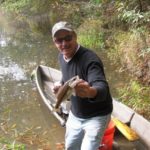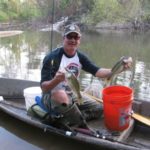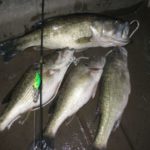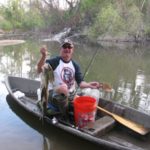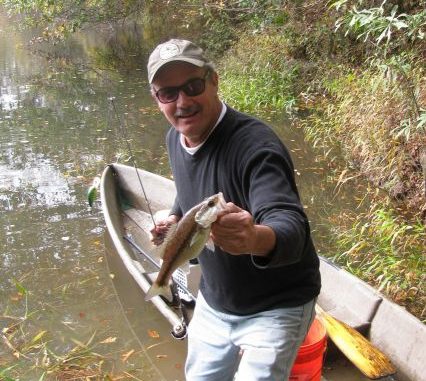
When the inevitable warm fronts move in, what’s a hunter to do? Take a break, and paddle these streams for some great fishing for spotted bass.
“You gotta be outcha mind!”
Artie was stuck on his favorite quip. Any suggestion from anyone in Doc’s den that festive evening provoked it, as Artie rolled his eyes and grimaced in mock horror.
But he had a point.
First, Spencer suggested the traditional deer hunting for this time of year. But the low temperature the previous night was an arctic 62 degrees.
And you know what that means in South Louisiana: The deer “hibernate” during daylight hours.
So Doc suggested some duck hunting. Well, the southeast winds that usher in winter warm fronts usually flood the coastal marshes, scattering the already skittish late-season ducks. And gnats bedevil any duck-hunters heck-bent on going anyway.
“How ’bout some fishing?” Eddie quipped. “Hear the trout are still turned on in Oak River.”
Well, the warm temperatures and frigid coastal waters means a fog blanket that throws another obstacle in the way of any coastal fishing plans (for most of the morning, anyway) for those without radar — the overwhelming majority of us.
So, yes, Artie had a point.
“Think I’ll try some freshwater fishing,” I shrugged.
Now Artie’s retort was echoed by everyone else.
“Yeah, right!” they sneered in chorus.
“Green trout and poych won’t be on their beds spawning for a couple months!” Artie laughed. “Fresh waaaaw-da fishing in January? Dumbest thing I ever hoyd!”
“Don’t worry — it’s a solo trip.” I smiled. “None of y’all are invited. And who said anything about fishing for spawning fish? I’m going after hungry fish. And I ain’t going far — you’ll see.
“I’m going after spotted bass in the local St. Tammany Parish streams. Nothing to it. I’m about ready for something leisurely like this. Why wait till spring and summer?”
In fact, those spring rains often make spotted bass fishing “spotty” indeed.
Clear water in those running streams in the Florida parishes is the most-important factor for this type of fishing — hands down. “Clear,” of course, is a relative term; in our experience, this means water clarities ranging from gin to partly-cloudy tea.
In general, the shorter the stream the greater the likelihood of finding its waters fishably clear. The farther north it starts, and the more creeks and branches it drains the greater the chances it will muddy up with those prefront showers so characteristic of January.
But there’s no better way to determine the stream’s fishability than having a look. If I can see about a foot into the water, it’s fishable.
After that, if you want the makings of a fish fry from these streams, target catfish. At least in my experience.
In brief, the traditional best months for freshwater fishing aren’t always the best for the type of freshwater fishing I had in mind.
What this type of fishing mostly requires is, as mentioned, fairly low streams and fairly clear waters — and it’s best out of a pirogue, kayak or canoe.
To wit: Motorboats can’t get much past Highway 21 on the Tchefuncte and Bogue Falaya rivers.
And Bedico Creek north of Highway 22 is impractical for most outboards.
Blow-downs and gravel bars block much of the way in the Tangipahoa River north of Highway 190.
A little north of Lacombe, Bayou Lacombe turns into a clear-water creek. The Bogue Chitto River west of Highway 41 — and especially of Highway 437 — becomes ideal for the paddler/panfisherman.
All of the above means intrepid paddle fishermen usually find plenty of elbow room in the upper reaches of these flowing streams. This means lightly-pressured — and thus — often gullible fish.
Add a stupefying backdrop of mixed upland and swamp scenery, a back beat of woodpeckers pecking and woodies squealing after erupting from the stream bends as you paddle along — imagine this soundtrack instead of outboards and jet skis roaring — and you’re talking fishing like the clichés’ describe it.
In summer, we’ll wear Crocs or Aqua-Socks for the occasional portage around blow-downs. In winter I prefer knee boots.
A qualifier: Heavy rains usually spoil any prospects for this type of fishing. But light rains are anything but a trip killer. In fact, they often help matters.
To wit: As explained to me by a LDWF biologist, in these barren, sandy-bottomed streams without aquatic vegetation or adjacent swamplands, fish often feed most actively when moderate to light rain washes in food from the surrounding woods, branches and ravines. The rest of the time they have to make do with the few forage fish and insects along the banks.
These streams aren’t like those in the Atchafalaya or Maurepas basins, or in other similar swamps known as “spillover” wetlands. In those, high tides give fish access to that broth of fish fodder (minnows, crawfish, terrestrial and aquatic insects, larvae, etc.) that live in the shallow, fertile, weed-clogged pools and sloughs in the surrounding swamp.
I heard all this from a biologist, and it made sense.
But finding a place to put in can be tricky nowadays. Parking on the highway shoulders near most of these stream bridges is strictly verboten by parish law.
Hence many of the few fisherfolk who engage in this type of fishing resort to float trips. Simply cajole a dutiful compadre to drop you off at one bridge and — nothing to it — pick you up at a lower one after a few hours.
HAH!
Alas, such dutifulness is not often available (especially in view of my compadres), so I opted to put in at a compadres private stream-front property on a stretch of the Little Tchefuncte between Highways 40 and 21, and simply paddle back upstream after fishing.
Otherwise, the Menetre Boat launch in downtown Covington provides easy access to the Bogue Falaya and Abita rivers. This place can get crowded, but mostly on weekends and during spring and summer.
By going upriver on the Bogue Falaya or Abita (especially on weekdays), paddlers can usually find some elbow room — and a fair number (of smallish, in this area) spotted bass.
A bit farther west, the Tangipahoa River offers the most options for float trips, with drop-off and pick-up points on bridges along Highways 16, 20, 442, 443, 190 and 22.
On top of those options, The Serenity Sands campground on Highway 40 offers — not a full-fledged boat ramp, now — but easy access to the river for kayaks, canoes and ’rogues. Here, during low-current periods, one can easily launch, paddle around and pick back up.
The Bogue Chitto has entry points for paddlers from ramps in Franklinton and a bit farther south in the Bogue Chitto State Park. (Please note: The popular Bogue Chitto Tubing Center on Choctaw Road in Isabel is closed during the winter months.)
Minutes after sliding my trusty pirogue into the frigid, flowing waters, some woodies erupted at my approach. As always, this provoked the age-old questions: “Where are they going? Why do they only fly 20 minutes of each day (10 minutes at dawn — 10 at dusk — and mostly before and after legal shooting time?)”
Whatever.
Generally speaking, you want to cast to the deeper, calmer holes along the bends of these streams, especially when they’re studded with blowdowns. Like all fish, these spotted bass don’t want to fight current needlessly. Instead they use it to push the bait to them, as they wait in currentless ambush points.
But in these narrow streams, I simply cast wherever I can — wherever I find casting room.
And often I’ll catch a spotted bass in the very middle in strong current. Indeed, I was about three cranks from finishing my 10th cast when my light spinning rod bent down furiously.
“Doggone it!” I snarled to myself. “KNEW I shoulda put on a white-and-chartreuse spinnerbait instead of my little chartreuse-and-orange crankbait! These little treble hooks catch ANY branch from ANY blowdown in the stream! But spinnerbaits slide right over ’em!”
Then the “branch” went airborne right pirogue-side — rattling its gills, splashing my astonished face and plunging back in for a spirited run that started my little Mitchell 308 singing its sweetest music.
“Man, this is what it’s ALL ABOUT!” I whooped to myself. “Man, but I was READY for this after so many fruitless vigils after nocturnal deer! Here’s ACTION at last!
“YEAH-YOU-RIGHT!”
Then I heard laughter!
“Whoops? What the …?”
Well, the riverfront backyard gazebo right up ahead had a little crowd that seemed to be prolonging their New Year’s festivities on this unseasonably balmy January morning. They seemed highly amused by some whooping lunatic in a pirogue.
After a few more runs, I swung the little bass aboard — then lifted it by the jaw and pointed it toward the spectators.
“Fresh fried fish for breakfast anyone?” I yelled. “Don’t get no bettah!”
As mentioned, this stream was narrow. So I was close enough to easily make out the celery tops sprouting from their glasses, and their smiles and pinkish faces. The women’s flutes seemed to contain mimosas.
“Yeah, you right!” they replied. “Fried fish and bloody Marys sure sounds good! Will you join us?”
“Maybe on the way back up.”
And I had just enough time to wave as the current took me around a bend, and I cast again.
“There he IS!” I whooped, as another little bass shot from the water in a gill-rattling leap.
Three more leaps, and I swung it aboard. I could still hear the gazebo crowd laughing.
Then a great blue heron flapped majestically from its perch atop an ancient, dead pine and distracted me, while casting again.
Up ahead loomed a classic “honey hole” — a deep (5 feet or so) hole with a blow-down sticking out of it. Here’s the type of place you want to target in these streams, and this is what simplifies this type of fishing.
In the wider, deeper streams (i.e., lower Tangipahoa, Bogue Chitto, Bogue Falaya, Tchefuncte rivers), the fish can be anywhere. Up here in the narrow, shallow reaches, the fish concentrate in the deeper, calmer holes that generally form where the stream bends.
If it’s studded with a few logs or stumps, it’s almost guaranteed to hold fish. Sure simplifies things.
What kind of fish, you ask? Well, along with the spotted (or Kentucky) bass, long-eared sunfish (the colorful ones with bright-orange bellies and turquoise-mottled faces some people call pumpkinseeds) and bluegills, sometimes spawning yellow bass, and channel and flathead cats.
I plopped the crankbait right behind a blow-down in the deep bend. On the second crank a fish hit it — and this one also went airborne.
What these fish lack in size they more than make up in muscle and acrobatics (and delicious flavor).
I tightened the drag a bit, as the bass angled downstream past me and into what passed for open water around here.
I savored every lunge, every leap, every dive — until I swung it aboard amidst a gill-rattling spray of cold water.
Man, I was pumped — and remained nonplussed even when I snagged branches with my next two casts. Such are the drawbacks of a crankbait in these snag-filled waters.
But — for whatever reason — I tend to catch more bass with these little crankbaits than with the most-popular lure for this type of fishing —a spinnerbait.
Crawfish make up a good portion of a spotted bass’ diet. But I often find little long-ear sunfish inside the stomachs of the larger ones. So maybe the orange/chartreuse coloring and fish-like action of the crankbait has something to do with it?
Fortunately, due to their small treble hooks, by simply paddling over and reeling down to the lure and jerking a little, it usually unsnags.
My next cast landed next to a cypress knee with current swirling around it. I had barely flipped the bail when the rod bowed and I felt the tug.
But no aerial acrobatics this time? Just a dogged back and forth, with short lunges as I worked the fish back.
Ah! A nice bluegill this time! That’s another thing I like about this crankbait: Sometimes bluegill and long-ears barely twice its size try to inhale it.
The “poych” was flopping in my bucket with all the bass when I cast toward a sandy bank just past the cypress tree.
WHAM!
The lure was smacked almost as it landed. Then made a sizzling run into the shallows; then back toward the tree.
Then out of the water in a gill-shaking leap.
Another leap.
Another run.
Some surface thrashing; and then he was at pirogue-side.
A dandy of a spotted bass, barely 13 inches long.
I ended up with eight bass — short of a limit, but what a ball.
For whatever reason (maybe the cool, clear water they live in), spotted bass strike me as absolutely delicious, slightly edging out (flavor-wise) their largemouth kissing cousins.
Such is my hankering for their white flaky flesh that I’ll often scale them and fry them whole, loath to waste even the rib cage meat while filleting.
Artie freaked when he saw my presentation — but those eight bass sure disappeared fast!
I was lucky to get one!
